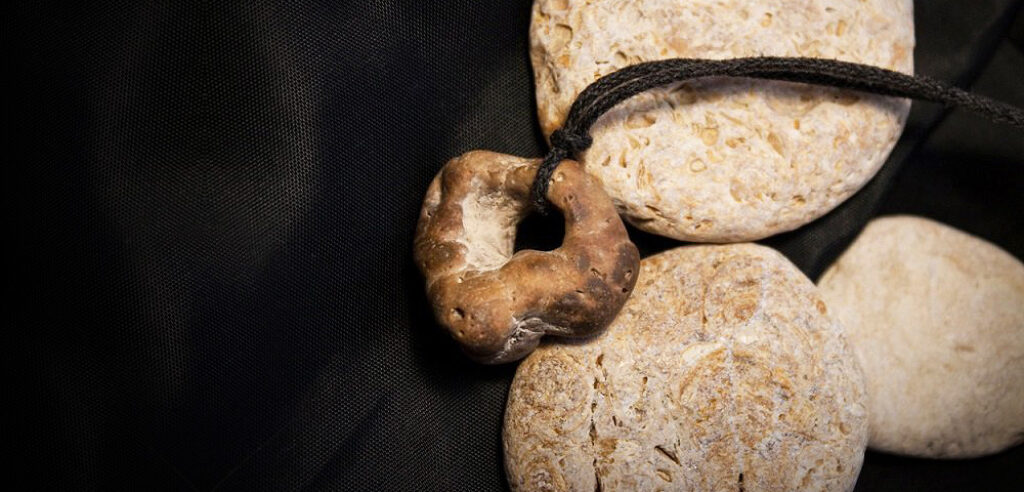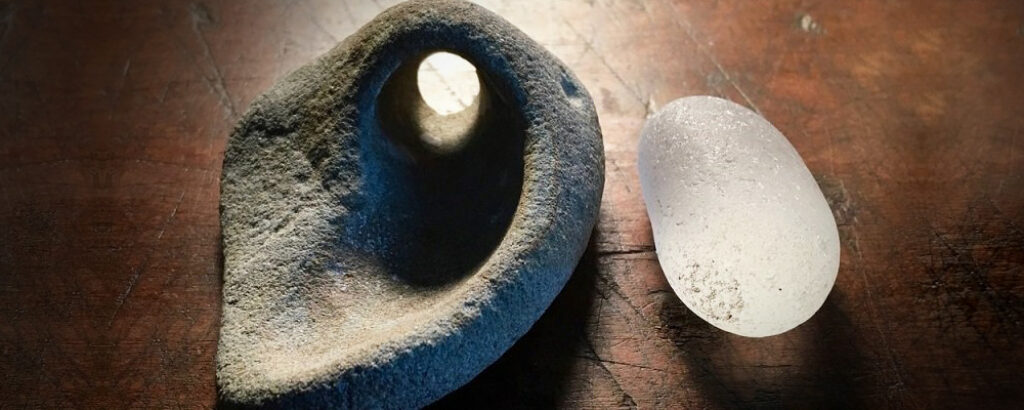Hag Stones, also known as Adder Stones, Witch Stones, or Serpent’s Eggs, among other names, are stones with a naturally occurring hole through them. These unique stones have captivated the human imagination for centuries, finding their place in various cultures and folklore around the world.

Steeped in mystery and legend, Hag Stones have been used in rituals, worn as talismans, and revered as protective amulets. They have been associated with magic, protection, and the ability to peer into other realms.
Formation and Physical Characteristics of Hag Stones
How Hag Stones are formed?
Hag Stones, or holey stones as they are sometimes called, are formed over time by the forces of nature. They are typically found in areas with high levels of erosion, such as coastal regions or near rivers and streams. The process of their formation involves two main natural mechanisms:
- Liquid Erosion: The most common way Hag Stones are formed is through the process of liquid erosion. When a softer stone is placed in the path of running water, the water gradually wears away at the stone’s surface. Over time, this erosion can create a hole in the stone. This process can take hundreds or even thousands of years, depending on the hardness of the stone and the intensity of the water flow.
- Boring Organisms: In some cases, Hag Stones are formed by the action of certain species of clams, such as the Pholadidae family, also known as piddocks or angelwings. These clams have the ability to bore into hard substrates, such as rocks, creating holes. Over time, these holes can become larger due to additional erosion, resulting in a Hag Stone.
Physical Characteristics
Hag Stones are characterized by their distinctive appearance, which includes a naturally occurring hole.

However, beyond this defining feature, these stones can vary greatly in their physical characteristics:
- Size: The size of Hag Stones can range significantly. Some are small enough to be worn as a pendant on a necklace, while others are large and heavy, more suited to be used as decorative pieces or protective talismans in the home. The size of the stone often depends on the type of rock and the conditions under which it was formed.
- Material: Hag Stones can be made from a variety of rock types. The most common are flint, sandstone, and limestone, but they can also be found in other types of rock. The type of rock can influence the color, texture, and overall appearance of the Hag Stone.
- Hole Size and Shape: The holes in Hag Stones are as varied as the stones themselves. Some have small, round holes, while others have larger, irregularly shaped openings. The size and shape of the hole are determined by the erosion process and the hardness of the rock.
- Surface Texture: The surface of a Hag Stone can be smooth or rough, depending on the type of rock and the conditions of its formation. Stones formed in water are often smooth due to the constant erosion, while those formed by boring organisms may have a rougher texture.
How to Identify Genuine Hag Stones and Avoid Fakes
Identifying genuine Hag Stones can be a fascinating process, but it also requires a keen eye and some knowledge about these unique stones. Here are some tips to help you distinguish real Hag Stones from fakes:
- Natural Hole: The defining feature of a Hag Stone is its naturally occurring hole. This hole should appear to be formed by erosion, which means it will have smooth edges and won’t be perfectly round or symmetrical. If the hole looks too perfect or machine-made, it’s likely not a genuine Hag Stone.
- Material: Genuine Hag Stones are typically made from natural rocks such as flint, sandstone, or limestone. If the stone is made from a material that doesn’t typically form Hag Stones, like certain types of gemstones or synthetic materials, it’s probably not genuine.
- Surface Wear: Real Hag Stones show signs of natural wear and tear. They should have a weathered look, with a surface that’s been smoothed by water. If the stone looks too new or lacks signs of natural weathering, it may be a fake.
- Weight and Density: The weight and density of the stone can also provide clues about its authenticity. Genuine Hag Stones should feel solid and heavy for their size. If the stone feels unusually light, it might be made from a synthetic material.
- Location: Genuine Hag Stones are most commonly found in areas with high levels of erosion, such as beaches, riverbanks, and other bodies of water. If you’re buying a Hag Stone, ask the seller about its origin. If they can’t provide a plausible source, it might not be genuine.
History
Use of Hag Stones in Druidic Rituals of Pre-Rome Britain

Hag Stones have a rich history that dates back to ancient times. In pre-Roman Britain, these stones were used extensively in Druidic rituals and were held in high esteem.
- Druidic Rituals: The Druids, who were the learned class among the ancient Celts, used Hag Stones in various rituals. According to Pliny the Elder, a Roman author and natural philosopher, the Druids believed that these stones were formed from the hardened saliva of serpents massing together. They were often used in healing rituals, divination, and protection spells.
- Symbol of Power: Hag Stones were considered a symbol of power and authority among the Druids. They were often worn by the Druids as amulets or used in ceremonies. Pliny the Elder wrote about a Druid who wore a Hag Stone bound in gold as a badge of his position.
- Magical Properties: The Druids ascribed magical properties to Hag Stones. They believed that these stones could help win lawsuits, gain access to kings, and even swim against the current when bound in gold. These beliefs highlight the significant role Hag Stones played in the spiritual and daily lives of the Druids.
Use of Hag Stones in Western Folk Magic and Medieval Witchcraft

In the realm of Western folk magic and medieval witchcraft, Hag Stones held a prominent place due to their perceived magical properties and protective abilities.
- Protection Against Evil: Hag Stones were often used as protective amulets against negative forces and evil spirits. It was believed that the naturally occurring hole in the stone could trap evil entities, preventing them from causing harm. They were commonly hung in homes, barns, or carried as personal amulets for protection.
- Healing and Health: Hag Stones were also associated with healing and maintaining good health. They were often worn around the neck or placed in sleeping areas with the belief that they could cure illnesses or ward off diseases.
- Witchcraft Practices: In medieval witchcraft, Hag Stones were used in various rituals and spells. Witches were believed to use these stones to enhance their magical abilities, cast spells, or communicate with other realms. They were also used as a tool to ward off witches and their spells, based on the belief that witches could not harm anything that was in close proximity to a Hag Stone.
- Fertility and Childbirth: In some traditions, Hag Stones were associated with fertility and childbirth. They were often used in rituals or kept as talismans to promote fertility, ensure a safe childbirth, or protect newborns.
Significance of Hag Stones in Different Cultures

Hag Stones have been recognized and revered in various cultures around the world, each attributing unique beliefs and uses to these fascinating stones.
- Irish Legends: In Ireland, Hag Stones are often associated with the “Good People” or fairies. They are believed to provide protection against fairy mischief and even allow the holder to see into the fairy realm.
- Welsh Mythology: In Wales, Hag Stones are known as Glain Neidr or Maen Magi, and are believed to be created by a congress of snakes. They are closely connected to Druidism and are often associated with magical properties.
- Scottish Folklore: In Scotland, Hag Stones are referred to as Gloine nan Druidh, meaning “Druids’ glass”. They are considered to have protective and healing properties, and are often used in rituals and ceremonies.
- German Folklore: In Germany, Hag Stones are called Hühnergötter, or “chicken gods”. They are believed to protect chickens from illness and are often placed in chicken coops for this purpose.
- Egyptian Folklore: In Egypt, Hag Stones are known as aggry or aggri. They are often used as protective amulets and are believed to ward off the evil eye and other negative forces.
- Russian Folklore: In Russian folklore, Hag Stones are associated with the spirit Kurinyi Bog, or “The Chicken God”. These stones are placed in farmyards to counteract the possible evil effects of the Kikimora, spirits who guard and care for chickens.
Folklore and Beliefs Associated with Hag Stones

Protective Qualities of Hag Stones
One of the most common beliefs associated with Hag Stones is their ability to provide protection. This belief spans across cultures and centuries, making it a key aspect of the Hag Stone’s folklore.
- Protection Against Evil: Hag Stones are often believed to ward off evil spirits and negative energies. The hole in the stone is thought to trap these harmful entities, preventing them from causing harm to the holder or their property.
- Protection of Livestock: In many rural cultures, Hag Stones were used to protect livestock. They were hung in barns or stables with the belief that they would prevent witches from souring the milk of cows or taking horses for a nocturnal ride.
- Protection at Sea: For sailors and those who made their living from the sea, Hag Stones were considered powerful protective amulets. They were often tied to ships to prevent witches from clinging to the vessel and to help disperse storm clouds.
- Protection in Sleep: Hag Stones were also believed to protect individuals during sleep. They were often attached to bedposts to ward off nightmares and ensure peaceful sleep.
- Protection Against Loss: Some people tie Hag Stones to their keys, believing that it will prevent them from getting lost.
Divination and Other Magical Properties
Beyond their protective qualities, Hag Stones are also associated with divination and other magical properties. These beliefs further contribute to the mystical allure of these unique stones.
- Seeing into Other Realms: One of the most fascinating beliefs about Hag Stones is their ability to allow the beholder to see into other realms. It is often said that if you peer through the hole of a Hag Stone, you can catch a glimpse of the fairy realm or see invisible entities.
- Healing Properties: In some cultures, Hag Stones are believed to possess healing properties. They are used in rituals or worn as amulets to cure illnesses or promote good health.
- Fertility and Childbirth: Hag Stones are often associated with fertility and childbirth. They are used in rituals or kept as talismans to promote fertility, ensure a safe childbirth, or protect newborns.
- Good Fortune: Some people believe that Hag Stones can bring good fortune. The hole in the stone is thought to allow good luck to pass through, while trapping bad luck.
- Spiritual Connection: Many people use Hag Stones in their spiritual practices. They are used in meditation, energy healing, and other metaphysical practices to enhance spiritual connection and promote personal growth.
Modern New Age Traditions and Beliefs Associated with Hag Stones
In the modern New Age movement, Hag Stones have found a place as powerful spiritual tools and protective amulets. Their natural formation and historical significance make them appealing to those seeking a connection with nature and ancient traditions.
- Energy Work: Many people in the New Age community use Hag Stones in energy work. They are believed to have a strong earth energy that can ground and stabilize one’s energy field. They are often used in chakra balancing, reiki, and other energy healing practices.
- Meditation and Mindfulness: Hag Stones are also used in meditation and mindfulness practices. Holding a Hag Stone or gazing through its hole during meditation is believed to enhance focus, promote clarity, and facilitate a deeper connection with the self and the universe.
- Protection and Warding: In line with ancient beliefs, many modern practitioners use Hag Stones for protection and warding. They are often placed in homes, carried in pockets, or worn as jewelry to ward off negative energies and protect against harm.
- Divination and Spirit Communication: Some modern practitioners use Hag Stones in divination and spirit communication. They are used in rituals or as tools in practices like scrying, with the belief that they can facilitate communication with spiritual entities or provide insight into the future.
- Crystal Grids and Altars: Hag Stones are often included in crystal grids or placed on altars due to their perceived spiritual properties. They are used to enhance the energy of the space, provide protection, or serve as a connection to earth energies.
Finding and Using Hag Stones

Where to Find Hag Stones?
Finding a Hag Stone can be a delightful experience, akin to discovering a small piece of natural magic. Here are some places where you’re likely to find these unique stones:
- Coastal Areas: Hag Stones are most commonly found along coastlines, particularly on pebble and shingle beaches. The action of the waves often erodes softer stones, creating the characteristic hole.
- Riverbanks and Streams: The banks of rivers and streams are also good places to find Hag Stones. The constant flow of water can erode stones over time, creating the distinctive hole.
- Gravel Pits: Gravel pits and areas with loose, eroded rock can also yield Hag Stones. The natural erosion processes in these areas can lead to the formation of these stones.
- Antique and New Age Stores: While finding a Hag Stone in nature can be a rewarding experience, they can also be purchased from antique stores, New Age shops, or online. However, it’s important to ensure that these stones are genuine and have been ethically sourced.
Tips for Finding Hag Stones

While Hag Stones can be found in various places, knowing what to look for and how to look can increase your chances of finding one. Here are some tips to help you in your search:
- Look in the Right Places: As mentioned earlier, Hag Stones are most commonly found in areas with high levels of erosion, such as beaches, riverbanks, and gravel pits. Start your search in these areas.
- Search After a Storm: After a storm, the strong winds and waves can dislodge stones and reveal hidden treasures. This is an excellent time to search for Hag Stones, especially on beaches and riverbanks.
- Check the Tide: If you’re searching on a beach, check the tide times. The best time to look for Hag Stones is during low tide when more of the beach is exposed.
- Look for Shadows: The hole in a Hag Stone can cast a distinctive shadow that makes it easier to spot. If the sun is shining, look for stones that cast unusual shadows.
- Feel the Weight: Hag Stones tend to be heavier than they look due to their density. If a stone feels unusually heavy for its size, it might be a Hag Stone.
- Be Patient: Finding a Hag Stone can take time and patience. Don’t be discouraged if you don’t find one right away. The joy of finding a Hag Stone often lies in the search itself.
Traditional and Modern Uses of Hag Stones
Hag Stones have been used in various ways throughout history, and many of these traditional uses continue today. Here are some of the most common ways Hag Stones are used, both traditionally and in modern times:
- Jewelry and Talismans: Hag Stones are often worn as jewelry, particularly as pendants on necklaces. They are believed to provide protection to the wearer and are also used as talismans for good health and fortune.
- Home Protection: Hag Stones are commonly used to protect homes from negative energies and evil spirits. They are often hung above doorways, windows, or placed in corners of the home.
- Spiritual Practices: In modern spiritual practices, Hag Stones are used in meditation, energy healing, and other metaphysical practices. They are believed to enhance spiritual connection and promote personal growth.
- Garden Decoration: Some people use Hag Stones as decorations in their gardens. They are believed to bring good luck and protect the garden from harmful energies.
- Dreamcatchers: Hag Stones are sometimes incorporated into dreamcatchers to enhance their protective qualities and ward off nightmares.
- Fertility and Childbirth: In some cultures, Hag Stones are used in rituals or kept as talismans to promote fertility and ensure a safe childbirth.
- Divination and Magic: Hag Stones are used in various forms of divination and magic, including scrying, spell casting, and spirit communication.
Hag Stone Meaning and Symbolism
Have you ever stumbled upon a stone with a naturally occurring hole and felt a sense of wonder and curiosity? These unique stones, known as Hag Stones, are steeped in mystery and folklore, carrying a rich tapestry of tales and beliefs from around the world.

Hag Stones, also known as Adder Stones, Witch Stones, or Serpent’s Eggs, are more than just stones. They are symbols of protection, healing, and connection to the natural world. Their allure lies not only in their physical characteristics but also in the myriad of meanings and symbolism they carry.
The Magic of Formation
The formation of Hag Stones is a testament to the power and persistence of nature. These stones are typically found in areas with high levels of erosion, such as coastal regions or near rivers and streams. The constant flow of water wears away at the stone’s surface, gradually creating a hole. This process can take hundreds or even thousands of years, imbuing each Hag Stone with a sense of deep time and history.
In some cases, Hag Stones are formed by the action of certain species of clams, such as the Pholadidae family, also known as piddocks or angelwings. These clams have the ability to bore into hard substrates, such as rocks, creating holes. Over time, these holes can become larger due to additional erosion, resulting in a Hag Stone.
Symbols of Protection and Healing
One of the most common beliefs associated with Hag Stones is their ability to provide protection. This belief spans across cultures and centuries, making it a key aspect of the Hag Stone’s folklore. They are often used as protective amulets against negative forces and evil spirits. The hole in the stone is thought to trap these harmful entities, preventing them from causing harm to the holder or their property.
In addition to their protective qualities, Hag Stones are also associated with healing. They are used in rituals or worn as amulets to cure illnesses or promote good health. The belief in their healing properties is a testament to the deep connection between humans and the natural world, a connection that Hag Stones embody and symbolize.
Windows to Other Realms
Perhaps one of the most fascinating beliefs about Hag Stones is their ability to allow the beholder to see into other realms. It is often said that if you peer through the hole of a Hag Stone, you can catch a glimpse of the fairy realm or see invisible entities. This belief underscores the mystical allure of these stones, inviting us to explore the unseen and the unknown.
A Connection to the Past
Hag Stones are also symbols of our connection to the past. They have been used and revered by various cultures throughout history, from the Druids of ancient Britain to the folk magic practitioners of medieval Europe. Each Hag Stone carries with it a piece of this history, serving as a tangible link to our ancestors and their beliefs.
In the modern world, Hag Stones continue to hold a significant place in various cultural and spiritual practices. They are used in meditation, energy healing, and other metaphysical practices to enhance spiritual connection and promote personal growth. They are also used as decorations in homes and gardens, bringing a touch of natural magic into our everyday lives.
The Power of Hag Stones
The power of Hag Stones lies not only in their physical properties but also in the meanings and symbolism they carry. They are symbols of protection, healing, and connection to the natural world. They invite us to explore the unseen, to connect with our past, and to embrace the magic of nature.
Frequently Asked Questions About Hag Stones
What is a Hag Stone?
A Hag Stone is a stone with a naturally occurring hole through it. They are also known as Adder Stones, Witch Stones, or Serpent’s Eggs.
How are Hag Stones formed?
Hag Stones are formed over time by the forces of nature, typically through the process of liquid erosion or by the action of certain species of clams that can bore into hard substrates.
Where can I find Hag Stones?
Hag Stones are most commonly found in areas with high levels of erosion, such as coastal regions or near rivers and streams.
What are Hag Stones used for?
Hag Stones have been used for various purposes throughout history, including protection against evil spirits, healing, divination, and as a tool in various spiritual practices.
Are Hag Stones rare?
While finding a Hag Stone can be a special experience, they are not considered rare and can be found in many parts of the world.
Can I wear a Hag Stone as jewelry?
Yes, many people wear Hag Stones as pendants on necklaces due to their believed protective and healing properties.
What does it mean if I find a Hag Stone?
Some people believe that finding a Hag Stone is a sign of good luck or protection. Others believe that you don’t find a Hag Stone, it finds you.
Can I buy a Hag Stone?
Yes, Hag Stones can be purchased from various online retailers, antique stores, and New Age shops.
How can I tell if a Hag Stone is real?
A genuine Hag Stone will have a naturally occurring hole that appears to be formed by erosion. The hole should have smooth edges and won’t be perfectly round or symmetrical.
Can Hag Stones be any type of rock?
Hag Stones can be made from a variety of rock types, including flint, sandstone, and limestone.
Do Hag Stones have healing properties?
Many cultures believe that Hag Stones have healing properties and they are often used in rituals or worn as amulets to cure illnesses or promote good health.
How should I care for my Hag Stone?
Hag Stones do not require any special care. However, you should avoid dropping or striking the stone as it may break.
Can I place a Hag Stone in my garden?
Yes, some people use Hag Stones as decorations in their gardens. They are believed to bring good luck and protect the garden from harmful energies.
Can I use a Hag Stone in divination?
Yes, some modern practitioners use Hag Stones in various forms of divination, including scrying and spirit communication.
Can a Hag Stone be used to protect livestock?
In many rural cultures, Hag Stones were used to protect livestock. They were hung in barns or stables with the belief that they would prevent witches from souring the milk of cows or taking horses for a nocturnal ride.


